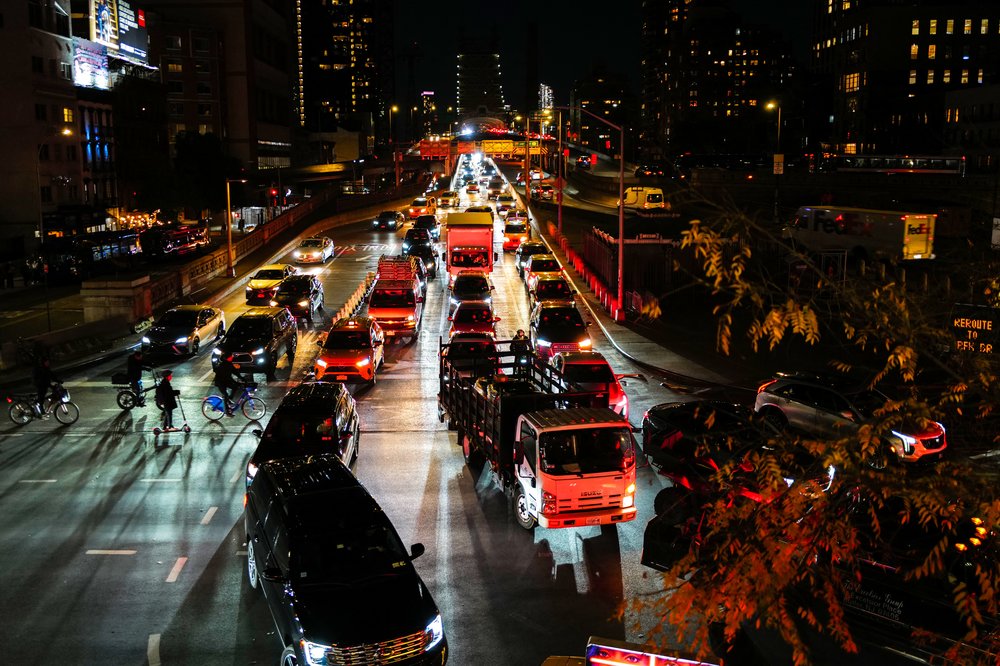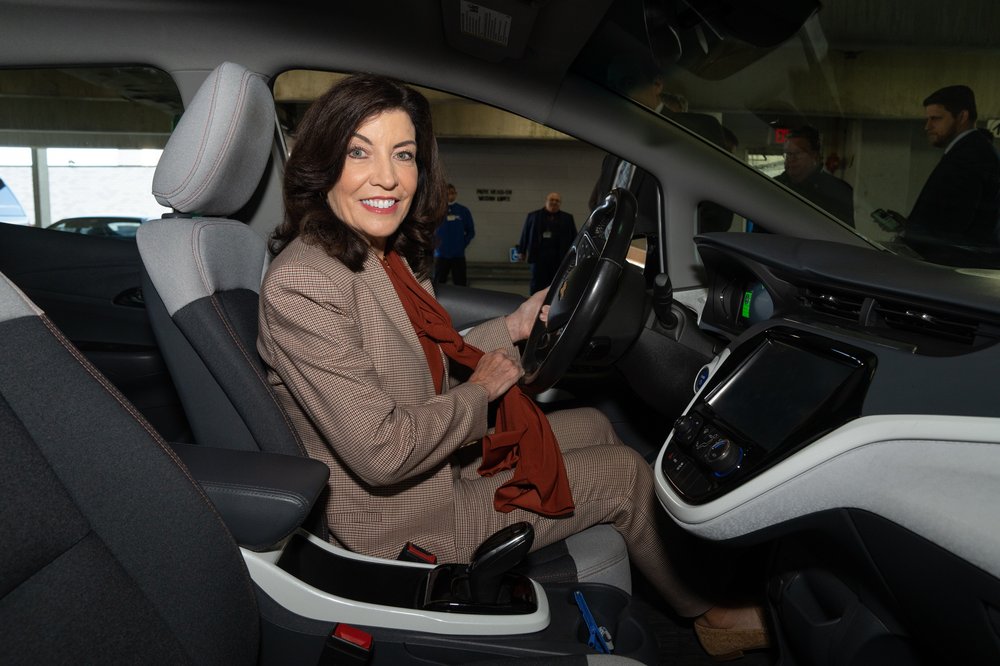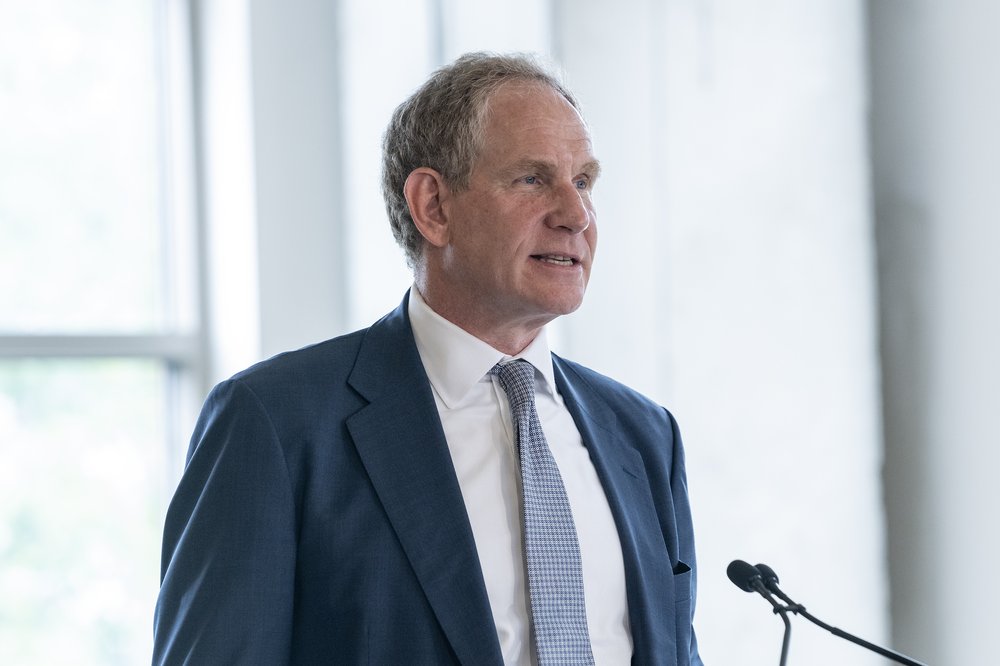NYC's congestion pricing tolls are live: What you need to know
Nov. 14, 2024, 2:17 p.m.
Gov. Kathy Hochul gave the MTA's long-planned tolling program the green light. Here's how much drivers will pay.

New York City’s congestion pricing program launched just after midnight Sunday, imposing tolls on drivers who enter Manhattan south of 60th Street. The program, which aims to reduce gridlock and finance $15 billion worth of transit repairs for the MTA, is the first of its kind in the United States.
In a development first reported by Gothamist, New York Gov. Kathy Hochul gave the MTA the green light to launch the tolls in November at a $9 base price. The fee is 40% less than the $15 base charge the MTA initially planned to charge before the governor temporarily halted the program in June.
The MTA began collecting fees right after midnight Sunday.
How much will drivers pay?
It depends on the time of day, what type of vehicle they’re driving and whether they’re using E-ZPass. The charges will be higher during the MTA’s peak period, which runs from 5 a.m. to 9 p.m. on weekdays and 9 a.m. to 9 p.m. on weekends.
Under Hochul’s plan, regular passenger vehicles with E-ZPass will pay:
- $9 during the peak period
- $2.25 during the overnight period
The costs are higher for commercial traffic, and vary based on the size of the vehicle.
Large, multi-unit trucks and sightseeing buses will be charged a peak toll of $21.60, down from $36. Smaller single-unit trucks — including pickup trucks and vans with modified beds, will pay $14.40 during peak hours, down from the previously approved $24.
Motorcyclists who have E-ZPass will pay a cheaper toll of $4.50 during the daytime period.
The overnight tolls are 75% cheaper, which Hochul said is designed in part to encourage overnight deliveries.
Yellow and green taxi trips that enter the congestion zone will also be hit with a 75-cent surcharge — while car rides in app-based services like Uber or Lyft will come with an additional $1.50 charge.
Any vehicle without E-ZPass will pay a 50% premium. For passenger vehicles, that means cars without the toll payment devices will pay $13.50 during the peak period and $3.30 overnight. The day congestion pricing launched, MTA Chair Janno Lieber warned drivers "to make sure your EZ-Pass account is connected to your license plate, otherwise you will end up being charged more because the system won’t know the EZ-Pass and the car are connected."
Are there any discounts available?
There are some, but they’re limited.
- Vehicle owners who made less than $50,000 in the previous year can enroll in a discount program, which cuts the daytime toll in half after their 10th trip in a month.
- Passenger-vehicle drivers who pay a toll to cross the Lincoln or Holland tunnels into Manhattan during peak hours will get a $3 discount on the MTA’s congestion toll.
- Entering or exiting the area via the Queens-Midtown or Brooklyn-Battery tunnels during peak hours will come with a $1.50 credit for passenger vehicles.
- Drivers who live in the congestion zone and earn less than $60,000 a year will be able to receive a tax rebate on any congestion pricing tolls they pay.
- State law requires some vehicles to be exempted from the toll, including emergency vehicles and those transporting people with disabilities. The MTA earlier this year agreed to extend that exemption to roughly 11,000 school buses and 15,000 municipal vehicles — and officials said those breaks will remain in place under the new plan.
- Larger vehicles like trucks and buses will get a similar credit for tunnel crossings, which varies based on the size of the vehicle.
- Motorcyclists who cross the Lincoln or Holland tunnels during peak hours will get a $1.50 credit against the congestion tolls, while those who pay the Queens-Midtown or Brooklyn-Battery tunnel tolls will get a 75-cent credit.

Will the tolls go up over time?
Yes. The MTA board approved a plan to graduallyraise the price of the tolls to $15 over the next six years.
The board plans to raise the base price for passenger drivers up to $12 in 2028, and then up to $15 in 2031, matching the same cost the MTA initially planned to charge upon the launch of the program.
State law requires congestion pricing to bring in enough revenue to finance $15 billion worth of bonds for the MTA to pay for transit upgrades. Hochul’s administration maintains the new, lower toll will allow the MTA to do just that — though it may require the agency to extend its schedule for paying the bonds back, which means they’ll end up paying more interest on the loans.
“We’re required to give the MTA basically a $15 billion credit card,” New York State Director of Operations Kathryn Garcia said in November. “It just may mean that it may take longer to pay it all back.”

For years, MTA Chair Janno Lieber has sought a congestion tax to help pay for transit upgrades.
What will the money be used for?
The goal of congestion pricing is twofold: reducing gridlock south of Central Park, and generating money for the public-transit system. Hochul’s administration estimates it will reduce traffic in the busiest parts of Manhattan by 13.4%.
The money will be used to fund the MTA’s current capital plan — a long list of repairs and infrastructure improvements needed to help keep the transit system operable. That list includes more modern train signals, new electric buses, high-tech subway cars, elevators and a planned expansion of the Second Avenue subway.
Hochul also directed the MTA to bolster service on 23 bus routes in boroughs outside of Manhattan to help commuters who are forced to switch from cars to mass transit as a result of the congestion toll.
Six of the express routes had already been announced, according to the governor’s office. They are the BM2, BM5, SIM1C, SIM4C, SIM23 and SIM24. The remaining routes will be selected by the MTA, she said.
“This would mean running buses more frequently along those routes,” she said.
Could congestion pricing be stopped again?
Opponents of congestion pricing have already tried and failed to halt the program. The tolls still face challenges.
While current President Joe Biden’s administration has been supportive of the plan, Donald Trump has vowed to stop the tolls once he returns to the White House on Jan. 20.
Hochul re-launched the tolls ahead of Trump’s inauguration, believing the move would make it more difficult for the new president to nix the program.
Five Republican House members from New York — including Staten Island Rep. Nicole Malliotakis and Hudson Valley Rep. Mike Lawler, a potential Hochul challenger in 2026 — sent a letterto Trump in November, pleading with him to rescind federal approvals once he gets in office late last year.
New Jersey Gov. Phil Murphy has also sued in federal court in an attempt to stop the program. A federal judge rejected the case, and lawyers for Murphy have threatened to appeal the decision to a higher court.
Gov. Hochul to relaunch congestion pricing with $9 base toll, sources say